Review: 6 Months Tracking Recovery & Strain with the Whoop Strap
"Train hard, recover harder" has become a mantra among fitness enthusiasts and elite athletes alike in recent years and the demand for foam rollers, massage guns, compression gear, ice baths, meditation apps, blue light glasses, and mobility programs has exploded. But which of those things are worth the time and money?
The Whoop Strap is a small computer with a PPG-heart rate sensor that you wear on your wrist that tracks metrics related to your recovery and training load 24/7 such as heart rate, heart rate variability, and respiratory rate. The strap analyzes these metrics alongside the quality of your sleep - the amount of mentally restorative rapid eye movement (REM) sleep and physically restorative slow wave sleep (deep sleep) you're getting compared to the time that you're in minimally beneficial light sleep or awake - and gives you a 'Recovery score' between 0 and 100% based on where you are in relation to your baseline.
The Whoop Strap is a small computer with a PPG-heart rate sensor that you wear on your wrist that tracks metrics related to your recovery and training load 24/7 such as heart rate, heart rate variability, and respiratory rate. The strap analyzes these metrics alongside the quality of your sleep - the amount of mentally restorative rapid eye movement (REM) sleep and physically restorative slow wave sleep (deep sleep) you're getting compared to the time that you're in minimally beneficial light sleep or awake - and gives you a 'Recovery score' between 0 and 100% based on where you are in relation to your baseline.
Whoop Strap 3.0 Details
• 5 days of battery with a 60-minute charge
• On wrist charging
• Water-resistant spec to IP68, fine for swimming
• Stores up to three days of data
• Metal frame, plastic body
• 3-axis accelerometer, 3-axis gyroscope, and PPG-heart rate sensor
• Bluetooth Low Energy (BLE) compatible
• Colors: 14+
• Weight: 0.64 ounces / 18.14 grams
• MSRP: $30 USD monthly
• www.whoop.com
• 5 days of battery with a 60-minute charge
• On wrist charging
• Water-resistant spec to IP68, fine for swimming
• Stores up to three days of data
• Metal frame, plastic body
• 3-axis accelerometer, 3-axis gyroscope, and PPG-heart rate sensor
• Bluetooth Low Energy (BLE) compatible
• Colors: 14+
• Weight: 0.64 ounces / 18.14 grams
• MSRP: $30 USD monthly
• www.whoop.com
It then gives you a recommendation for how much strain your body can handle on any given day and records a 'Strain Score' out of 21 for each day that denotes how hard you've exerted yourself. A light walk might be a 3 on the strain scale, while a hard all-day mountain bike ride would likely get you up to 19 or 20 on the scale. If you slept soundly and have a 70% recovery, Whoop might suggest that you build up to a 15 strain for an optimal balance of strain and recovery. If you had a couple too many drinks and stayed up late and your Recovery score is only 31%, Whoop would suggest that you take it easy that day and only build up to a 7 strain for the day. Your strain is based on your max heart rate and the duration of the activity.
Unlike competitors Garmin, Suunto, Fitbit, or Apple Watch, you don't need to pay for the hardware up front. Instead, you pay a monthly fee for the product, which ranges from $18 USD per month if you commit to 18 months, or $30 USD if you pay monthly, and the hardware comes with the membership. The wearable doesn't work without the membership since the hardware needs to connect to the analytics software via Bluetooth in order to give you recommendations for how much sleep to get and how much training load you should be able to sustain on a given day.
If you're curious about the impact of something like stretching, hydration, alcohol, caffeine, eating vegetarian, light exposure, or having a sauna are on your Recovery score, you can choose to log those specific behaviours in the 'Journal' and your Monthly Performance Assessment will analyze your Recovery scores from each day. For example, if you want to know whether having caffeine after a certain time affects your sleep, you would select to track that in the journal, and then every morning you would record what time you had your last coffee in the app. At the end of the month, Whoop's analytics will let you know whether your recovery score is impacted by what time of day you consume caffeine.
While the main target is undoubtedly fitness enthusiasts and elite athletes, Whoop is really about looking at yourself as a a high performance machine from every angle and the company has done research with elite knowledge workers like CEOs and professors who want an extra cognitive or psychological edge over others in addition to athletes.
Getting Started
Whoop sends you the strap and charger in the mail when you subscribe to a membership online, and from there it is easy to adjust it to your wrist and connect it to your phone through the Whoop app. Whoop says that you should wear the strap just behind your wrist bone for the most accurate reading and suggests the left arm for right-handed people.
You immediately get readings after your first sleep, but the strap will be calibrating to your body to learn its baseline metrics for the first four days you wear it. After four days, you receive your first Recovery score which is the personalized measure of how ready you are to take on Strain. If you're between 67 and 100%, your score will be green, if you're between 34 and 66%, your score will be yellow, and if you're between 0 and 33%, your score will be red. After five days, the Strain Coach feature is unlocked and will give you suggestions for how much training load you can sustain that day based on your recovery.
After seven days, Whoop begins to give you recommendations for what time you should go to sleep and wake up since consistent sleep times have been proven to improve the quality of your sleep.
After 14 days, you get your first Weekly Performance Assessment which is a weekly breakdown of your last 7 days of data. After 30 days, you get your first Monthly Performance Assessment in your app, which goes into detail on the habits that you are tracking.
Using the Whoop Strap
Unlike a bulky sports watch, the Whoop Strap is extremely low-profile and it's easy to forget that you're wearing it. It's also much more discreet than traditional sports watches if you want to wear it out to dinner or during a meeting. Its small size also means that the heart rate data is more accurate than an ill-fitting watch, especially for people with smaller wrists, because the heart rate sensor is always close to your skin. After six months, I still find it hard to unlock the clasp and I generally pull it on and off over my hand unless I have a pointy object at hand to pry the clasp open, but otherwise, I find it very comfortable and easy to use.
One feature that is excellent is that you can charge the watch while it's still on your wrist. The app will give you a notification when the strap is below 20% battery life, after about five days, and then you simply slide the charger on top of the watch and go about your day while the watch charges back up.
While the device isn't waterproof when it is charging, it's otherwise quite bombproof and you can wear it in the sauna, swimming, in the cold, and on muddy bike rides. You can also take the strap off the sensor and throw it in the washing machine when it gets dirty, or swap it out for another since Whoop offers about 900 different coloured straps. Of course, I chose the oil slick option.
You can either track your activities by pressing "Start" and "Stop" in the app, or you can let the app auto-detect your activities. The strap itself does not have a GPS in it, but if you start and stop your activities when you head out manually, you can enable your phone's GPS to track the distance. If you let the app auto-detect your activity, it will only record your heart rate data and not your route. If you choose, you can pull your Whoop data into Training Peaks, Strava and Equinox+.
The auto-detect option is impressively accurate, and most of the time the app can figure out whether I went on a mountain bike ride, a run or a hike just based on my heart rate data. If it's uncertain, it will just log "Activity" in the app. Occasionally, I have had it register an activity with a higher score than accurate (for example, an easy walk with a 15 score when those are usually 4-6), but for the most part, I've been impressed with its ability to record and then analyze my heart rate data to determine what activity I just completed.
When I compared the average heart rate from my Whoop strap with my Garmin computer and a heart rate strap, I found it to be within a couple beats per minute most of the time, although the Whoop strap takes a second longer to adjust when you adjust your intensity.
The strap analyzes the quality of your sleep - the amount of mentally restorative rapid eye movement (REM) sleep and physically restorative slow wave sleep (deep sleep) you're getting compared to the time that you're in minimally beneficial light sleep or awake. After seven days, Whoop begins to give you recommendations for what time you should go to sleep and wake up since consistent sleep times have been proven to improve the quality of your sleep.
As for tracking sleep, I initially would press the "Start" and "Stop" options for that, but I found it ironic to have to press a button on my phone to use a device that is supposed to help me learn to sleep better, so I started just letting the app figure out what time I went to sleep and what time I woke up. With this, I've found it best to leave the app open in the background when you go to sleep so that it doesn't take too long to analyze the sleep and calculate your recovery score in the morning. Occasionally, the app will think I woke up earlier than I did or went to bed later than I did, but you can adjust the sleep time retroactively if it detects it incorrectly and overall I found the Recovery scores to accurately reflect how my body was feeling the majority of the time.
I also find it interesting to delve into how much deep sleep I get each night compared to how much REM sleep and at what time of night each phase of sleep occurs. If you want to nerd out about sleep, I highly recommend this podcast with Dr. Matthew Walker and his book "Why We Sleep." Whoop told me that you should aim to have half of your total sleep in REM and deep sleep phases.
While I initially used the Journal feature extensively, I found it time-consuming to track a whole bunch of different categories or too difficult to quantify and so I have streamlined the categories that I track. I think the Journal feature is one of the most interesting things about the Whoop Strap however since it makes me more aware of the things I do each day and how each behaviour impacts my sleep and recovery scores. One thing that I got really interested in thanks to the Whoop Strap is cycle tracking and how hormones affect you differently at different parts of the month. If you are a woman or have any female athletes in your life, I highly recommend reading Roar by Dr. Stacy Sims.
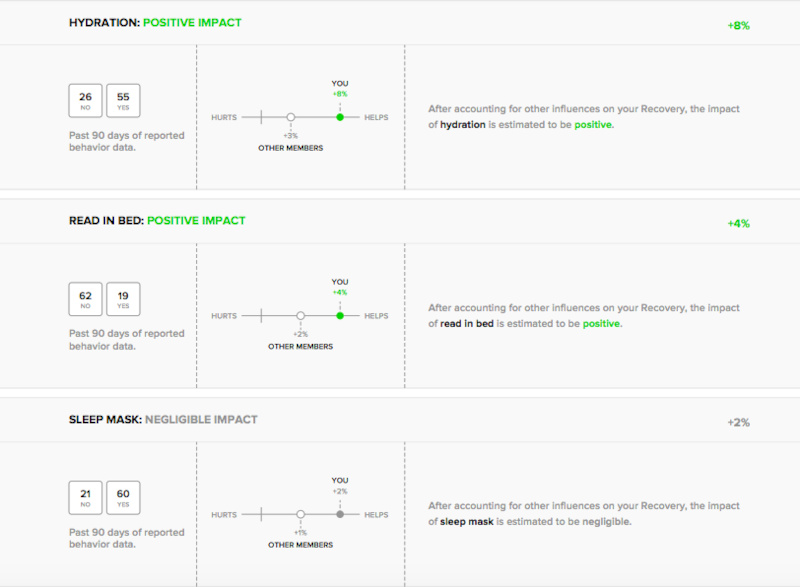
I think the Journal feature is one of the most interesting things about the Whoop Strap however since it makes me more aware of the things I do each day and how each behaviour impacts my sleep and recovery scores.
Limitations
While the strap might start to give you Recovery scores, sleep recommendations, and strain recommendations early on, I found that the Whoop Strap gets better with time. At first, its recommendations for sleep were on the low side and it would recommend that I get less sleep than I was actually getting. Over time, it started to give me more accurate sleep recommendations.
I also had a glitch with my heart rate data early on, where the strap measured my heart rate at 193 beats per minute. Since my maximum heart rate is closer to 180, that wasn't an accurate high heart rate and so all of my Strain scores were on the low side. I spoke with a Whoop representative, and they were able to lower that artificially high heart rate in my profile so that all of my Strain scores were more representative of how hard I was working. Whoop said that any member is able to chat with a Whoop agent and get that score changed and also that the Day Strain is independent of the Recovery score. That means that even if you just wear the strap to sleep and don't wear it during the day, you should still get an accurate Recovery score.
The wearable also works better for cardio-based workouts than strength workouts I found. Since your heart rate is very low during a strength workout and bounces around a lot, the Strain score usually registers quite low compared to the perceived effort. If you try to get into the optimal strain score on a day that includes a strength workout, I found I would usually end up overdoing it and spend a couple of days in the yellow.
Another limitation I found was that the device only stores three days of data. Therefore, when I headed out for a long weekend out of cell phone service, I lost a day of data and lost my data streak. Not a big deal, but something to consider.
Something that is both a good thing and a limitation is that the strap doesn't have a GPS in it. That means that it relies on your phone's GPS to record your ride, run or other activity distance, and if you leave your phone at home, you'll only get the heart rate data unless you bring another device with you like a Garmin or Wahoo computer to track your ride's elevation, distance, and route. The plus side of not having a GPS in the device is that the battery life is much, much better than your average sports watch or cycling computer. Whoop said that they elected not to have a screen on the strap to improve that battery life as well.
Pros
+ Small, comfortable and discreet
+ Great battery life, charges on wrist
+ Robust app and analytics
+ You get to know what helps and hinders your performance
Cons
- Subscription based
- No integrated GPS
- Only stores 3 days of data
Pinkbike's Take
Author Info:
Must Read This Week
[UPDATED] Final Elite XC Results & Overall Standings from the Mairiporã XC World Cup 2024
42303 views
42303 views
Sign Up for the Pinkbike Newsletter - All the Biggest, Most Interesting Stories in your Inbox
PB Newsletter Signup
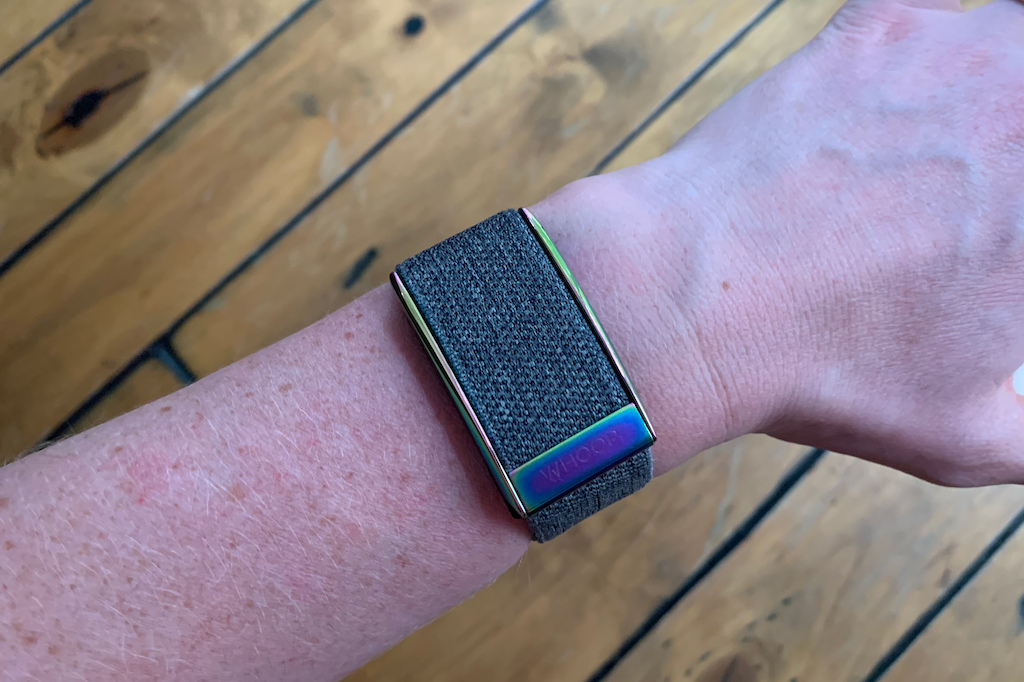

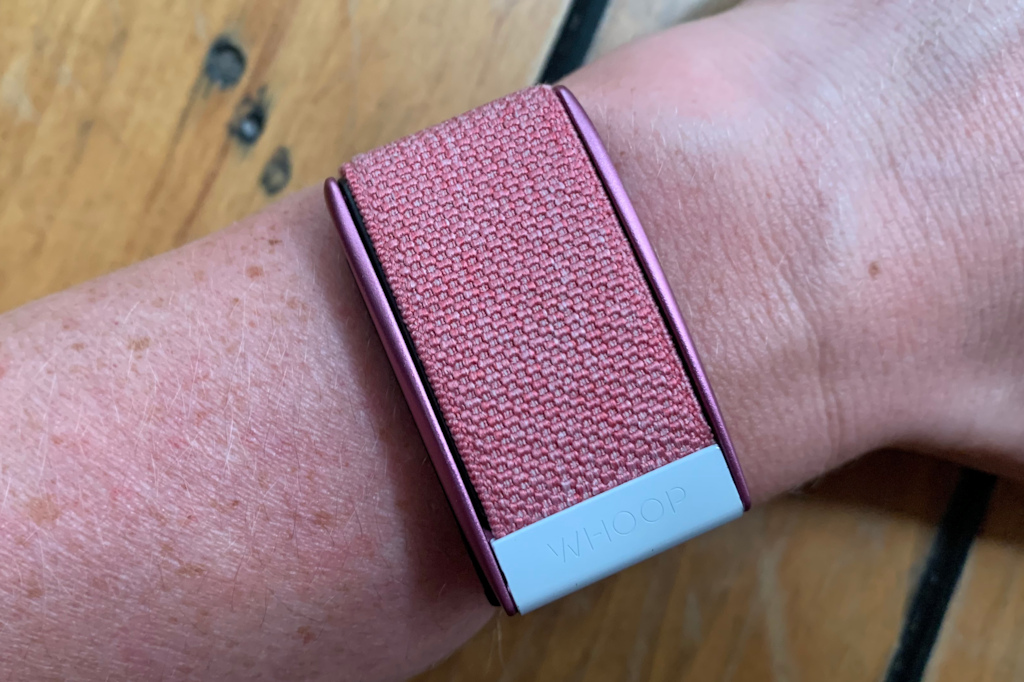
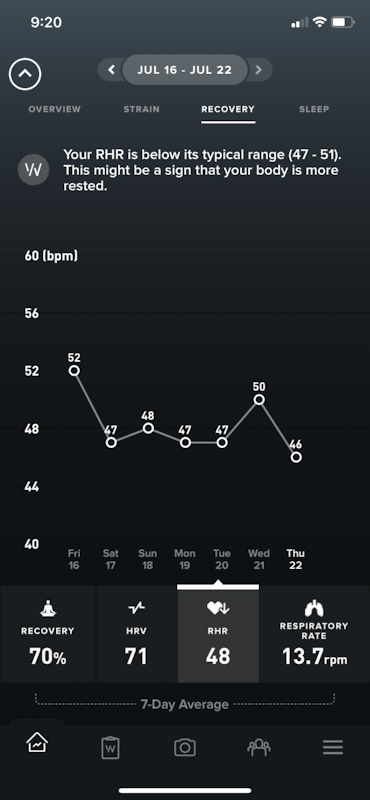


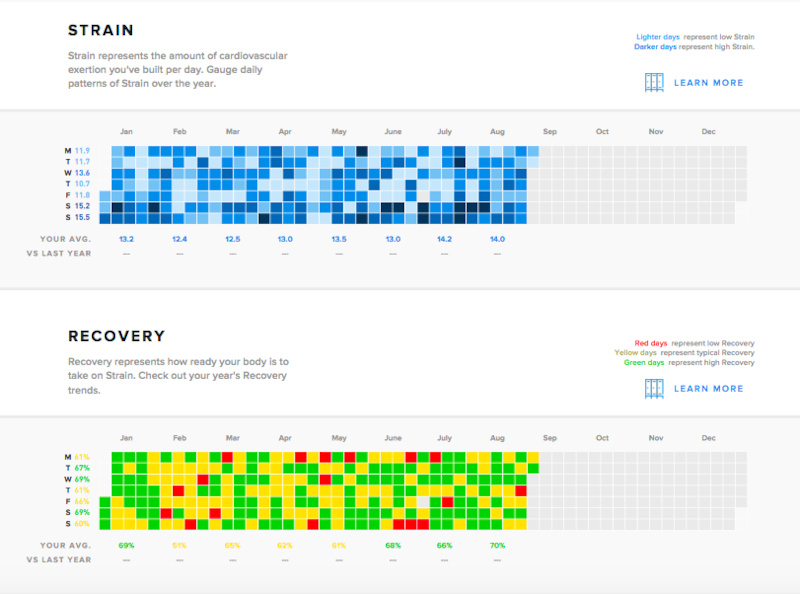
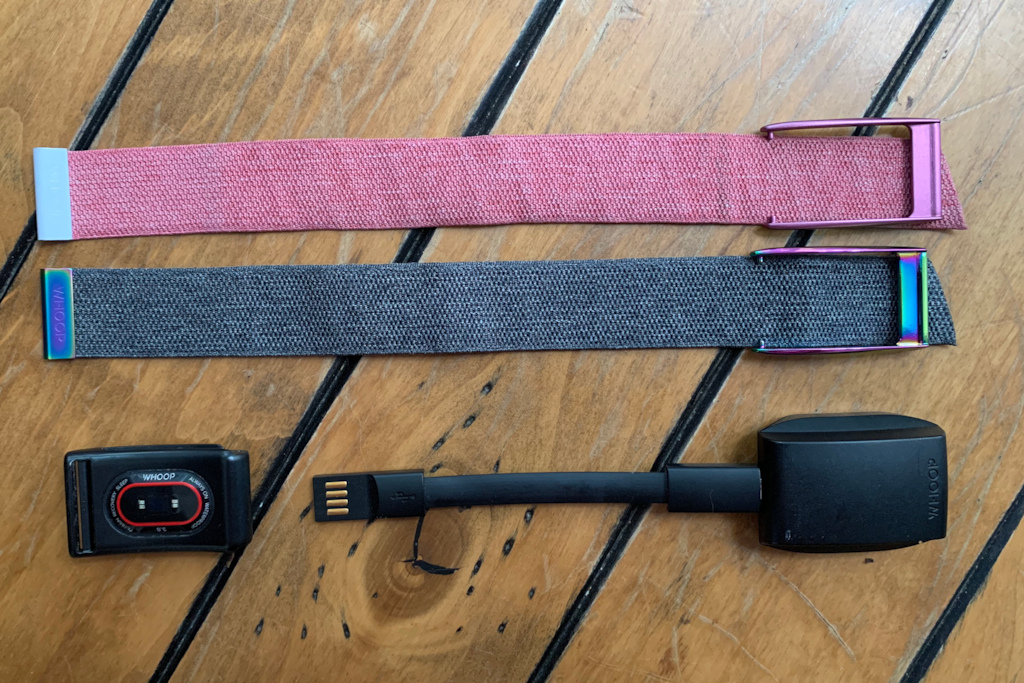
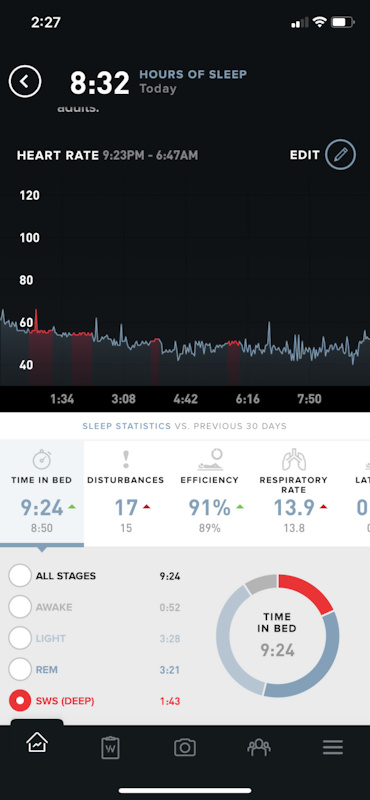
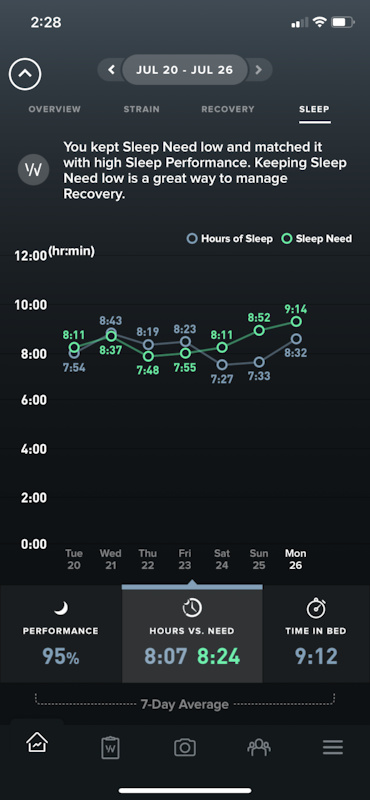
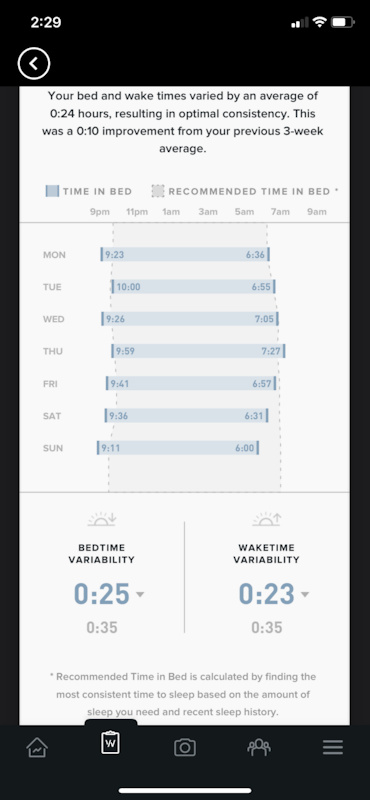

Second, "predicting" performance potential is a slippery slope at best. We all have had or witnessed performances that shouldn't have happened if based solely on current objective and subjective data. At best, these measurements can be used to calculate the cost of something, but not predict future performance. For example, if your recovery score is 30% it doesn't mean you can't go out and set PRs or have a terrific performance. But it could mean that you most likely won't do that 2 days in a row without taking some time to recover, as the tank eventually runs dry.
A fair amount of research is being done with HRV and recovery/performance, but as usual, the marketplace jumps on something and runs with it before we have a good amount of info. WHOOP is just that, they had a ton of seed money and were slick with their marketing and partnerships. They are by far not the best device on the market. IF you're interested in exploring other options, I would suggest looking into Morpheus (trainwithmorpheus.com) or Omegawave (omegawave.com) as options.
OR
You could ride your bike, have fun, and rest when you feel like it (assuming you're not a pro racer who actually makes a living off of riding).
So yeah this product sounds fancy, and I'm sure lots of people will be thrilled about it, but in reality data it gives out are more or less useless, as they are based on input data having whole bunch of errors.
Use the watch only for mellow activities when HR- accuracy is not as important such as hiking, yoga or a chilled afternon ride and when it comes to actual training rides or workouts, use a chest strap.
As for sleeping, i don't really see the point of knowing how much time you spent in what sleep phase but most wearables will do an alright enough job of detecting when you go to sleep and when you get up which can help you to dial in the regularity of your sleep patterns which should also improve your sleep. (For everyone whos watch sucks at detecting those times, just analyze the HR and movement)
And if you want to go down the rabbit whole, there ist a youtube channel called "The Quantified Scientist" that does scientific testing of wearables.
I've red a way better approach to test whether you need rest a while back.
If you feel lazy and tired and you think it's because you need a rest day:
Do another day of workout and if you still feel the same the day after: Take a rest day!
Most of the times I feel better the day after.
TL;DR: Apparently the performance of the optical wrist based HRM technology largely depends on the skin type. It would be good if the manufacturers would test for those different types and report so that potential buyers can decide up front whether it is going to be for them or not.
Dylan Johnson did a pretty good review a while back. Consistently there were days where his HRV said he was totally GTG but his legs felt like crap. A relatively easy 2-hr road ride maxed out the strain score. I really only think these things (Oura, etc. included) are pretty useless unless you're truly terrible at listening to your body.
On top of that for those of us who have high mental stress jobs, it has absolutely no way of measuring this, so would insist that I was well rested and ready for a workout when in reality I was a complete wreck.
In other words, they charge you a lot of money to tell you absolutely nothing useful.
0/10, would NOT recommend.
I missed having a watch. Yeah, I could take out my phone, but I’m so used to having the time on my wrist, the quick flick of the wrist to tell the time was a let down on the whoop.
Take always for me… it was justification for when I was sick. For whatever reason, when I’m sick, I don’t believe it (even if I’m dragging ass). But when I had single digit scores, instead of calling myself weak, I’d say
‘Hey, maybe I am sick”. Stupid, I know. My garmin tells me that now with my “body battery”. The numbers were cool in the beginning. I did learn that I go to hard to often, but again, other wearables can provide that feedback without a subscription.
Other than that, the quality was disappointing. Mine broke (wouldn’t charge anymore), but I was over it at that point and it was getting towards the end of my subscription (which is stupid). I’m sure they would’ve replaced (maybe?), but the product was lack luster at the end. It didn’t tell time… not a watch. The sleep score wasn’t accurate. If I take a nap with my garmin, my recover (body battery) adjust. With whoop, that’s your recovery score for the day, even if you crush a huge nap (again 2.0 version). Every ride i did was 20.5. It was always the same. No variation. 2 hours riding with friends to all day soul crushers… same score.
Most people I know, like the whoop in the beginning, but don’t renew the subscription. Your experience may vary.
The watch won't proactively tell you to slow down on a ride because you had a stressful day or anything like that, but it does give you a "body battery" measurement that is calculated based on your stress levels, sleep quality, and previous exercise activity. I've found is a decent metric for how hard you can/should go in a given workout.
"This sucks I quit…."
Only when the product is really good is a subscription super frustrating
$30/month is a 6K down payment on a 25 yr mortgage. So from my standpoint I see it as easily convertable to $6000 of captal....and therfore worth $6000.....this is not a $6000 strap.
Not sure who wants this sort of tracking on their body 24/7 but is avoiding having an actual watch on their wrist? Maybe I am missing something here?
On-body recharge is clutch if you're training for something and literally don't want to miss a beat (pun made itself, so intended I guess).
No screen helps prevent a feedback loop: just train and see what it meant later, instead of trying to maintain some numbers on the screen. Not saying one training method is better or worse, but some people can't help but chase the data if it's available realtime so the enforced delay can be quite useful.
If you're missing something, maybe it's just not for you. The seemingly "copy-paste from a press release wrapped in a few hundred words of personal anecdotes" contained in this article certainly doesn't help in that regard.
So you could just go with how you were feeling in the first place I guess then?
Does basically the same things, without subscription. I have one and like it.
Looks at mirror... ya... no...
I also find the strap, especially the metal part a bit uncomfortable, mostly when laying in bed.
I'm not sure if it really gives me any benefits, my wife gifted it to me, I wouldn't have spent that much (or any) money on it.
BTW 99.9% of the gen pop probably need to do more, not less… those weekly bimbles don’t equate to much, you’re not overtrained, you’re just unfit
www.youtube.com/watch?v=Z-FPimCmbX8
I mean whoop there it is....
www.youtube.com/watch?v=xvFZjo5PgG0
enjoy both...
I find the recovery scores pretty useful. Yes you often already know you’re run down or good to go, but HRV is a good measurement for those days when you’re not sure.
That being said, if you want that helpful data in your monthly performance dashboard, you have to be dilligent about filling out your daily journal.
If you’re just out playing in the woods on a bike, absolutely just go ride ya bike.
What exactly makes you think it got it wrong? Isn't that the point of this, to tell you things you can't detect on your own? Maybe you were more dehydrated on that walked than other walks? Maybe you had worse sleep the night before. Which goes to:
"Occasionally, the app will think I woke up earlier than I did or went to bed later than I did, but you can adjust the sleep time retroactively"
Why would adjust it? Unless it's grossly off and registered super early bedtime because you laid on the couch and zoned out watching a movie, aren't you supposed to trust it? If it just detected a slightly late bedtime or early rise, doesn't that just mean you maybe didn't fall asleep as rapidly as you thought or "woke" earlier than your brain noticed?
No but really, who comes up with these names!?
Ahahah